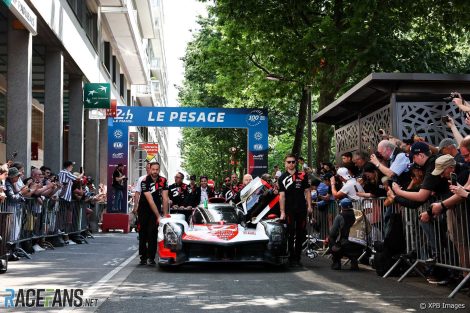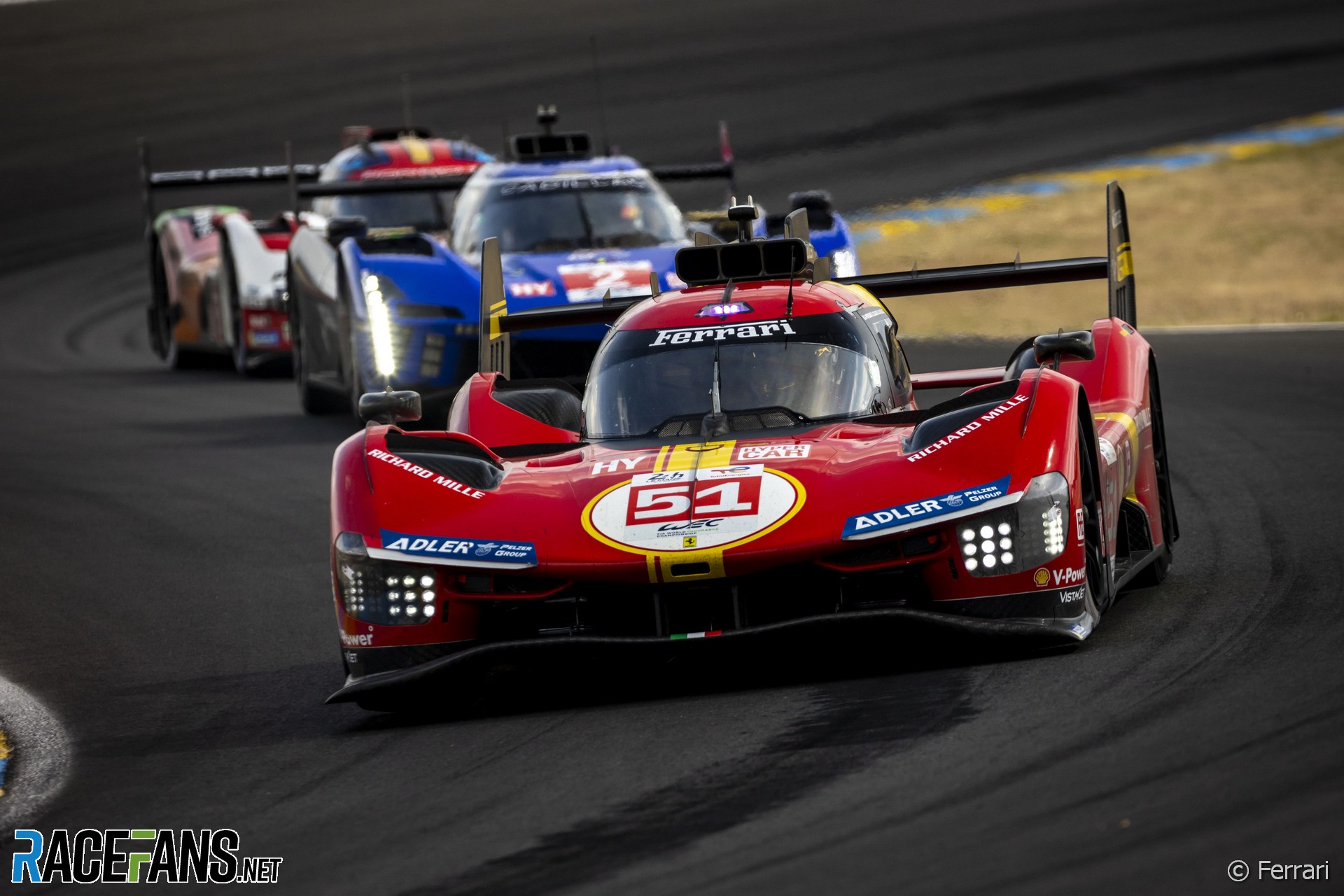Last weekend the world’s most famous endurance race, the Le Mans 24 Hours, celebrated 100 years since its first running.
A thrilling race-long battle between Toyota and Ferrari ended up with the Scuderia claiming their first overall victory in the race for over 50 years.
The event looks to be heading into a new golden age as the hypercar regulations have lured more manufacturers to the French town than it’s seen for many years. The likes of Max Verstappen and Charles Leclerc have also admitted they would like to tackle the event one day. So what could Formula 1 learn from one of the biggest motorsport events in the world?
Respect the road
What makes Le Mans special isn’t the duration – it’s far from the only 24-hour race in the world – or even the roster of competitors. It’s the track.
The Circuit de la Sarthe is that rarest of things: A grand old circuit which has not only retained its character through the years while adapting to modern safety standards, but is arguably an improvement over the original.
There wasn’t much for drivers to do on early iterations of the track besides accelerate for minutes on end and hope their brakes would still work the next time they touched them.
F1 can learn a lot from how successfully the Le Mans organisers have preserved the challenge of their track without completely neutering it. Yes, the interruption of the mighty Mulsanne straight by two chicanes in 1990 is regrettable. But at least these are flowing bends unlike, for example, Monza’s clumsy Rettifilo, and the straight remains one of the quickest sections of track outside of a superspeedway.
The La Sarthe circuit’s ultra-fast layout, which demands minimal downforce, is a vital part of Le Mans’ challenge and appeal. It remains hair-raisingly narrow through some of its quickest sections – so much so that the track doesn’t qualify for the FIA grade one licence necessary to hold F1 races.
It shows old tracks can be modernised more successfully than some F1 venues have been. The 2015 reworking of Mexico’s Autodromo Hermanos Rodriguez is a case in point: While the dauntingly fast Peraltada corner was never going to be suitable for modern F1 cars given its non-existent run-off, was it truly necessary to neuter almost every other corner as well? See also the ruining of the Hockenheimring, the tedious final sector at the revamped Fuji (it’s no coincidence F1 has since left both) and the infestation of asphalt run-offs at countless other tracks.
F1’s latest efforts have been better. Zandvoort was successfully brought up to modern standards with the intelligent use of banking. Elsewhere, F1’s unloved changes have been reversed such as at the Circuit de Catalunya this year. We may never see F1 racing at Le Mans, but the track serves as a brilliant example of the value of retaining classic venues.
Keith Collantine
Advert | Become a RaceFans supporter and
Keeping an eye out
As a multi-class event with both GT cars and hypercars sharing the 13 kilometre circuit at the same time for an entire 24 hours, traffic is a major concern for all drivers competing at Le Mans – just ask Kamui Kobayashi.

Yet despite the huge difference in speeds between the fastest and slowest cars on the track, accidents involving cars of varying classes happens less frequently than you might expect. While this is largely down to the exceptional discipline and professionalism of the over 100 drivers permitted to race at Le Mans, there are some tools used by the drivers in the endurance classic that F1 could likely benefit from too.
As GT drivers naturally have to spend a lot of time looking in their mirrors due to being passed multiple times a lap by much quicker cars, many GTE and GT3 spec racing cars now come with advanced driver warning and radar systems. Much like the reverse-facing cameras growing more and more popular on road cars, many GT cars feature large screens on the dash that show a permanent view directly behind the car in a view that is more convenient and often clearer than that offered by standard mirrors. Also, these systems regularly feature advanced warning lights to alert drivers that faster cars are approaching without them even needing to take their eyes off the road.
Formula 1 drivers still have to expend much of their brainpower on being aware of cars behind them and keeping out of the way of rivals. They are often forced to rely totally on their engineers who are themselves trying to determine whether or not a car they see on the track map is on a push lap, preparing to start one, or has backed off. The success they are having can be gauged by Pierre Gasly’s double penalty for impeding at the last race and Leclerc’s similar sanction at the previous round.
The slightly larger mirrors introduced this year appear to have made little difference for drivers to be aware of what is coming up behind them. A little Le Mans inspiration, whether in the form of a warning light system or even a permanent camera feed, could be one way of giving drivers an easier time out on the track.
Will Wood
Advert | Become a RaceFans supporter and
Flat-out action
There’s an immediate level of irony that a 24-hour race was more of a sprint race than many grands prix which rarely last more than two hours.

But that’s by design, not coincidence. Improved reliability over the past decade has increasingly turned the top level of prototype sports car racing into flat-out sprints. New technology isn’t exactly the buzz word behind Le Mans anymore, so managing hybrid systems isn’t a point of learning either.
Despite a lot of Safety Car periods early on, the final third of this year’s race was all about the drivers at the front pushing each other to the limit. When tyre-saving did come into account, as with Toyota’s Brendon Hartley, it was a decision weighed up against what could be gained from pushing the tyres to the limit rather than an immediate management exercise as it is in F1, and even its support series.
The on-the-limit driving eventually led to one of the two victory contenders making a race-losing mistake, which is rarely seen in F1. Before the days of Red Bull dominance, and wheel-to-wheel tussles between Lewis Hamilton and Verstappen, the last memorable occasion when the pace of one driver pressured another into a mistake was Sebastian Vettel’s slip-up while being chased by Hamilton at the 2019 Canadian Grand Prix.
Without an emphasis on technical complexity, it has become easier for teams to join Le Mans’ top class. And when there’s more cars, a mistake – particularly early in the race – now costs you more positions. The best thing about that last weekend was seeing how teams responded to such moment: telling their drivers to push.
This format isn’t just entertaining for fans, but in itself is part of the appeal to teams and manufacturers wanting to join and put on a show. F1 has already committed itself to half-hour sprint races, a concept that would seem ridiculous half a decade ago, so why not adjust grand prix lengths to enable flat-out racing if the series’ technological push and tyre configuration is not going to enable that under the current race format? IndyCar already varies lap counts in a way that it believes benefits the racing rather than sticking to a rigid length for every race.
However, talking about the quality of Le Mans’ competition this year has to be measured up against the impact the Balance of Performance changes made before the event, which arguably neutralised any kind of competitive advantage that Toyota had held. Without that contentious BoP ruling there may well have been no lead fight to speak of, though the flat-out battles behind would likely still have gone ahead.
Ida Wood
Advert | Become a RaceFans supporter and
The grand parade
Formula 1 and Le Mans are two completely different entities and unique forms of motorsport, and for me, both should remain that way.

For a start, the differences between the two are staggering. World Endurance Championship races are much longer than F1 races, hence the term “endurance racing”, and the majority of races last six hours, bar Le Mans which is 24 hours. F1 races are far shorter with a cap on overrunning. One has 20 cars, one has 62. One has a single class, one has three (four if you include the ‘Garage 56’ entry).
Not just that, but many forget that Le Mans is part of the WEC calendar, of course, with added competitors, much like the Indianapolis 500 is just part of the IndyCar series. With a huge list of competitors, Le Mans is a spectacle in itself and should be treated as the jewel in the crown it is.
One key difference with Le Mans is Friday’s annual Grande Parade Des Pilotes through the historic streets of Le Mans. There is an argument this could be adopted by F1 and added to various race weekends such as Las Vegas and Miami. The trouble is, when would F1 be able to schedule such an event?
Of course, it’s fantastic for the fans – but F1 race weekends, in which there are 22 this season, start on a Thursday and end on a Sunday night. There is little wiggle room and the driver’s time is quite precious with media and sponsor commitments. Yes, they’re paid the big bucks for a reason, but the weekends are intense for everyone.
F1 is different. Some rounds like Monaco stand out, but I believe each race should be treated as an equal. Fans should get the same treatment wherever they decide to watch a race. It should not be determined by location outside of what the track is offering. For example, if you’re going to Monaco, by nature of the surroundings, that will be very different from a race like Austria.
I do not think F1 should focus on Le Mans for inspiration. Both should have their place and identity on the calendar and we should avoid homogenising. Let’s enjoy them for what they are, unique in their own right.
Claire Cottingham
Advert | Become a RaceFans supporter and

















